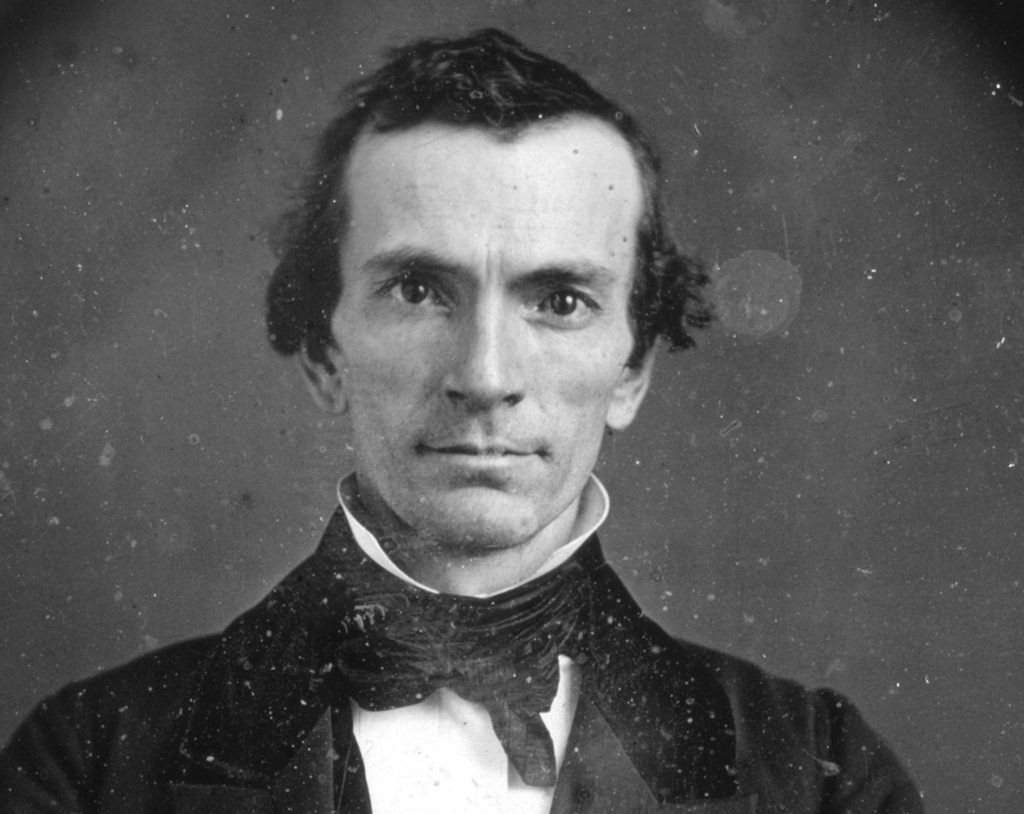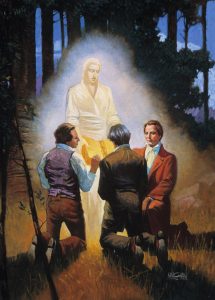
Daguerreotype of Oliver Cowdery found in the Library of Congress, taken in the 1840s by James Presley Ball. Image and caption via Wikipedia.
Oliver also provided the earliest independent affirmation of the experience on record. In November 1829, a few months after the vision took place, Oliver wrote to a skeptical enquirer describing the experience:
It was a clear, open beautiful day, far from any inhabitants, in a remote field, at the time we saw the record, of which it has been spoken, brought and laid before us, by an angel, arrayed in glorious light, ascend out of the midst of heaven.[4]

An Angel Showing the Gold Plates. Artwork by William L. Maughan.
In addition to these brief statements referring specifically to his angelic witness, Oliver related, defended, and testified of the origins of the Book of Mormon throughout an extensive corpus of personal writings and publications.[8] In one well-known example, found in a letter to W. W. Phelps, Oliver wrote of his experience as Joseph Smith’s scribe: “These were days never to be forgotten—to sit under the sound of a voice dictated by the inspiration of heaven, awakened the utmost gratitude of this bosom! Day after day I continued, uninterrupted, to write from his mouth, as he translated … the history, or record, called ‘The book of Mormon.’”[9]
Beyond the large corpus of such first-hand statements, many who heard Oliver testify left behind their recollections of his testimony. Edward Stevenson remembered frequently hearing Oliver testify “that he beheld the plates, the leaves being turned over by the angel.”[10] Numerous accounts from skeptics and believers alike consistently report that Oliver often testified of seeing an angel and the plates during his missionary travels to Ohio in the fall of 1830.[11] William E. McLellin and Thomas B. March each remembered occasions when Oliver and David Whitmer testified together of their shared vision of the angel and plates.[12]
There is less documentation of his testimony during the time Oliver was out of the Church.[13] Still, his personal correspondence with Church members and leaders reveals a continued faith in the events of the Restoration and a desire to be reunited with the Saints.[14] In these letters, Oliver expressed a desire to live his life in a way that his credibility as a witness would not be called into question.[15]

Photograph, unknown photographer, circa 1845. (Church History Library, Salt Lake City. Copy by Coe studio, 1883.) Image via josephsmithpapers.org.
When Oliver returned to the Church, several witnesses remembered him testifying of the Book of Mormon.[18] According to a “verbatim report,” taken down as Oliver Cowdery spoke at Council Bluffs, Iowa in October 1848, he declared, “I beheld with my eyes, and handled with my hands, the gold plates from which [the Book of Mormon] was transcribed.”[19] When he died less than two years later, several witnesses said that he bore testimony of the Book of Mormon shortly before passing.[20] Among these was his wife, who recalled in a letter:
My husband, Oliver Cowdery, bore his testimony to the truth and divine origin of the Book of Mormon, as one of the three witnesses of the Book of Mormon …. From the hour when the glorious vision of the Holy Messenger revealed to mortal eyes the hidden prophecies which God had promised his faithful followers should come forth in due time, until the moment when he passed away from earth. He always without one doubt or shudder of turning affirmed the divinity and truth of the Book of Mormon.[21]
By Neal Rappleye, cross-posted with the permission of Book of Mormon Central from their website at Evidence Central.
Additional Statements
1829
- “It was a clear, open beautiful day, far from any inhabitants, in a remote field, at the time we saw the record, of which it has been spoken, brought and laid before us, by an angel, arrayed in glorious light, [who] ascend [descended I suppose] out of the midst of heaven. Now if this is human juggling—judge ye.”[22]
1830
- About two weeks since some persons came along here with the book, one of whom pretends to have seen Angels, and assisted in translating the plates….The name of the person here, who pretends to have a divine mission, and to have seen and conversed with Angels, is Cowdray.[23]
1846
- I have cherished a hope, and that one of my fondest, that I might leave such a character, as those who might believe in my testimony, after I should be called hence, might do so, not only for the sake of the truth, but might not blush for the private character of the man who bore that testimony. I have been sensitive on this subject, I admit; but I ought to be so—you would be, under the circumstances, had you stood in the presence of John, with our departed Brother Joseph, to receive the Lesser Priesthood—and in the presence of Peter, to receive the Greater, and looked down through time, and witnessed the effects these two must produce,—you would feel what you have never felt, were wicked men conspiring to lessen the effects of your testimony on man, after you should have gone to your long sought rest.[24]
1848
- I wrote, with my own pen, the entire Book of Mormon (save a few pages) as it fell from the lips of the Prophet Joseph, as he translated it by the gift and power of God, by the means of the Urim and Thummim, or as it is called by the book, Holy Interpreters. I beheld with my eyes, and handled with my hands, the gold plates from which it was transcribed. I also saw with my eyes and handled with my hands the Holy Interpreters. That book is true. …It contains the everlasting gospel, and came forth to the children of men in fulfillment of the revelations of John, where he says he saw an angel come with the everlasting gospel to preach to every nation, kindred, tongue and people. It contains principles of salvation; and if you, my hearers, will walk by its light and obey its precepts, you will be saved with an everlasting salvation in the kingdom of God on high.[25]
- Hiram Page reported: “Among his last words, was to reaffirm his testimony to the Book of Mormon.”[26]
March 1850
- Oliver Cowdery just before breathing his last, asked his attendants to raise him up in bed that he might talk to the family and his friends, who were present. He then told them to live according to the teachings contained in the Book of Mormon, and promised them, if they would do this, that they would meet him in heaven. He then said, ‘Lay me down and let me fall asleep.’ A few moments later he died without a struggle.[27]
Date?
- When Thomas B. Marsh, an excommunicated apostle, approached Whitmer and Cowdery to learn “the real truth” about the Book of Mormon (since they, like him, were now excommunicated and hostile to it) Marsh reported:
I enquired seriously at David if it was true that he had seen the angel, according to his testimony as one of the witnesses of the Book of Mormon. He replied, as sure as there is a God in heaven, he saw the angel, according to his testimony in that book. I asked him, if so, how did he not stand by Joseph? He answered, in the days when Joseph received the Book of Mormon, and brought it forth, he was a good man filled with the Holy Ghost, but he considered he had now fallen. I interrogated Oliver Cowdery in the same manner, who answered me similarly.[28]
- The thing which impressed me most of all was, as we stood beside the grave of Oliver Cowdery the other Witness, who had come back into the Church before his death, and [David Whitmer] in describing Oliver[‘]s action, when bearing his testimony, said to the people in his room, placing his hands like this upon his head, saying ‘I know teh Gospel to be true and upon this head has Peter[,] James and John laid their hands and confer[r]ed the Holy Melchisedic Priesthood.’ [29]
- “Mr Whitmer felt very indignant while speaking of certain statements published recently to the effect that he and Oliver Cowdery had denied their statement as published in the Book of Mormon. This he denounced as false in every particular. He said: “Oliver never wavered in his testimony, and when he was on his death bed, I was there, with many of his friends, until he passed away. He bore the same testimony on his dying bed that he had always borne through life, and earnestly called upon all to cleave to the truth revealed through the Prophet Joseph, and to serve the Lord. As for myself, I have never denied my testimony that is published in the Book of Mormon, for I know that God has revealed these things for the salvation of the children of men, and to Him belongs all the honor, the power and the glory.”[30]
- Edward Stevenson: “I have often heard him [Oliver Cowdery] bear a faithful testimony to the restoration of the Gospel by the visitation of an angel, in whose presence he stood in company with the Prophet Joseph Smith and David Whitmer. He testified that he beheld the plates, the leaves being turned over by the angel, whose voice he heard, and that they were commanded as witnesses to bear a faithful testimony to the world of the vision that they were favored to behold, and that the translation of the Book of Mormon was accepted of the Lord….”[31]
- Elizabeth Ann (Whitmer) Cowdery (Oliver’s wife): “My husband, Oliver Cowdery, bore his testimony to the truth and divine origin of the Book of Mormon, as one of the three witnesses of the Book of Mormon….”[32]
- Philander Page, son of Hiram Page: [he] “was present at the deathbed of Oliver Cowdery….Oliver conversed with the brethren and reaffirmed his testimony to the Book of Mormon and to be faithful to their testimony.”[33]
- In 1876, John Whitmer wrote a lengthy letter to Mark Forscutt, which included the following:
Oliver Cowdery lived in Richmond, Mo., some 40 miles from here, at the time of his death. I went to see him and was with him for some days previous to his demise. I have never heard him deny the truth of his testimony of the Book of Mormon under any circumstances whatever. . . . Neither do I believe that he would have denied, at the peril of his life; so firm was he that he could not be made to deny what he has affirmed to be a divine revelation from God. . . .
I have never heard that any one of the three or eight witnesses ever denied the testimony that they have borne to the Book as published in the first edition of the Book of Mormon. There are only two of the witnesses to that book now living, to wit., David Whitmer, one of the three, and John Wh[itmer], one of the eight. Our names have gone forth to all nations, tongues and people as a divine revelation from God. And it will bring to pass the designs of God according to the declaration therein contained.[34]
Notes
Some or all of this content is used by permission of FairMormon.